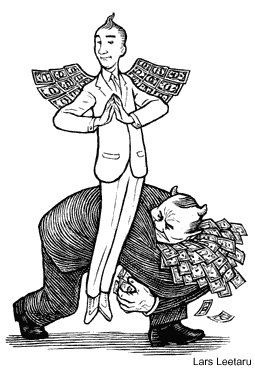The Vision Thing
Why did American Express outperform Wells Fargo, IBM beat Burroughs, and Motorola crush Zenith? Because they reconciled the tension between values and numbers.
I was lucky enough in the '80s to have an extraordinary Canadian as my boss. I was the editor of the Sunday Times of London, and my boss was a barber's son from Timmins, Ontario, who made the bulk of his fortune after he was 60. Roy Thomson was a flagrantly frugal man. Once, when we were on a trip to Miami, in a bizarre attempt to buy the memoirs of Howard Hughes, Roy ribbed me at the coffee shop for purchasing copies of the New York Times as well as the Miami Herald. Why did I need two newspapers?
 It was half in jest, half in earnest. It happily confirmed to him his epigrammatic judgment that the social mission of every great newspaper was to provide "a home for a large number of salaried eccentrics." But the man who questioned my quarters was content to plow millions into Times Newspapers Ltd. He was right to want us to watch our pennies, but he was ready to invest in men and machinery when his chairman, the very considerable journalist Denis Hamilton, told him that he had to do that to maintain the quality and potential of the newspapers. Roy believed passionately that if he held to his vision, not only would he create newspapers in which he could take pride, but he would be rewarded - in this life, he would say, rather than the next. He carried a little card in his pocket on which he had written his principles, and he would fish it out when asked to bring pressure on an editor. "You wouldn't expect me to go back on my word, would ya?"
It was half in jest, half in earnest. It happily confirmed to him his epigrammatic judgment that the social mission of every great newspaper was to provide "a home for a large number of salaried eccentrics." But the man who questioned my quarters was content to plow millions into Times Newspapers Ltd. He was right to want us to watch our pennies, but he was ready to invest in men and machinery when his chairman, the very considerable journalist Denis Hamilton, told him that he had to do that to maintain the quality and potential of the newspapers. Roy believed passionately that if he held to his vision, not only would he create newspapers in which he could take pride, but he would be rewarded - in this life, he would say, rather than the next. He carried a little card in his pocket on which he had written his principles, and he would fish it out when asked to bring pressure on an editor. "You wouldn't expect me to go back on my word, would ya?"
The corrupt print unions effectively destroyed Roy's Times, but when Rupert Murdoch bought the company after Roy's death, and sorted out the unions with satisfyingly cunning and ruthless tactics, Roy's investment in quality paid off, in marvelous multiples to this day.
I thought of Roy the other day when I read that the owner of the paper on which I had spent my resented quarter in Miami, Knight Ridder, is hell-bent on racking up the profits at the flagship newspaper, the Philadelphia Inquirer, and also the Philadelphia Daily News. Since 1995, good management and enterprising journalism have seen profit margins double to 19 percent. But that is not enough, say the Wall Street analysts, who note that some newspapers have achieved 30 percent. And so for 2001 Knight Ridder has set itself a new objective, a 21 percent profit margin.
I wonder.
I believe there's a paradox here: In an enterprise of quality, setting profit targets as the first priority risks quality — and longer-term viability. In all the newspapers with which I have been associated over 40 years in both Britain and America, only one of them a loss-maker, those that endured and flourished were the ones at which the objectives were not financial, but editorial and communal. And the ones I have known at which short-term profit margins were sacrosanct sooner or later fell by the wayside — generally sooner. Of course, as John Maynard Keynes said, in the long run we are all dead. I recognize that the handsome profits now being earned at the Sunday Times, for instance, are the fruits of 30 years of investment along with good management today — and that requires deep pockets, steel nerves, etc. But the profits would not be so high today if the journalistic objectives had been progressively diluted over the years.
Investing in Public Interest
I recall one instance in which the priorities were assessed. We had committed some of the cleverest people on the newspaper to investigating what was then the world's worst air disaster, the loss of 346 lives when a door fell off a DC-10 airliner leaving Paris — a door that was supposed to have been replaced after a similar door failed on a DC-10 two years earlier. It was an expensive investigation, involving us in research in Washington and Seattle and legal proceedings in California. In an attempt to cover some of the costs of the print exercise, we invested in simultaneously making a television documentary we could sell internationally. The film gave us publicity, but it lost us £60,000.
The cross-financing stratagem came up for review at a board meeting, at which I knew the brilliant and tough-minded finance director, Michael Brown, would have something to say. Mr. Brown, who with his vision of a modern data company later went on to transform the International Thomson Organisation, surprised me with his brusqueness. "DC-10. TV loss of 60,000 noted. Congratulations to the editor on the investment in the public interest and the reputation of the Sunday Times. Next item."
At the Philadelphia Inquirer, the management will no doubt insist that it intends to maintain standards, and maybe it will be possible to retain the newspaper's distinctiveness and popularity with readers and advertisers in the face of all the new electronic competition newspapers now face. Maybe, despite the projected budget cuts of 5 to 7 percent, the stars on the staff will declare, like W.C. Fields's epitaph supposedly reads, "On the whole, I'd rather be in Philadelphia."
My point is not so much conditions in Philadelphia, but the risks all kinds of management run when strategy boils down to an exercise in arithmetic. Of course, it is necessary to have a more sophisticated idea of what budgeting can do than the one memorably expressed by George W. Bush: "It must be a budget; it has a lot of numbers in it." Budgets are indispensable, but I would argue that they should always be thought of as tools, not targets. When this caution is suggested to them, management executives conventionally agree that this is indeed how they think of budgets. Nonetheless, the temptation is always present to lose sight of the vision in a lot of numbers.
I call as a prime witness Henry Ford, whose faith in reincarnation makes it easy for him to be with us today. The famous decision by Ford and his financial director, the flinty James Couzens, to double the Ford Motor Company's basic rate of pay for men to the amazing figure of $5 a day in January 1914 is well enough known, but the origin of it is too often today ascribed to narrow calculation. At the time, nobody in his right mind thought the economics could possibly turn out to be as sound as they proved to be in reducing turnover, giving workers a profit-sharing incentive, and creating a whole new class of customers who could afford to buy the cars they made. The publisher of the New York Times, Adolph S. Ochs, remarked, "He's crazy, isn't he?" The Wall Street Journal, as representative then as now of the counting house, called Ford a criminal. But what really horrified the Journal was the heart of the decision. The newspaper saw $5 a day as "the application of spiritual principles where they don't belong" and a threat to organized society.
The Journal was wrong in prediction, but right in diagnosis. Ford would never have made the decision had he not been exposed much earlier than once thought to the philosophical teachings of Ralph Waldo Emerson. Biographer Robert Lacey found a slender, worn blue volume of Emerson heavily marked in the summer of 1913 with Ford's spidery exclamations of approval. Ford, who was achieving vast savings in labor costs from the continuously moving assembly line, noted the following in Emerson's essay on compensation: "In labor as in life there can be no cheating. The thief steals from himself. The swindler swindles himself…." And again he noted: "He is great who confers the most benefits. He is base — and that is the one base thing in the universe — to receive favors and render none.... Beware of too much good staying in your hand. It will fast corrupt and worm worms."
From Manager to Tycoon
Ford, in later life, took pleasure in making it sound as if his "Five Dollar Day" was just a matter of "efficiency engineering … one of the finest cost-cutting moves we ever made." It was a neat way of getting back at the fellow capitalists who had denounced him for "the most foolish thing ever attempted in the industrial world." In fact, as Mr. Lacey concludes, "there was true generosity and not a little rashness" in the initiative taken by Ford and Couzens.
Henry Ford as social engineer might, of course, have been a commercial disaster without Henry Ford the shrewd line manager, but line managers without vision don't become tycoons. The recognition of the tension between values and numbers is the first requirement of the strategic manager, and it is the effective reconciliation of that tension that marks a great manager like Jack Welch. David Packard put it well: "Profit is not the proper end and aim of management. It is what makes all the proper ends and aims possible." You could look around, he said, and still see people who are interested in money and nothing else, but the underlying drive in successful companies comes largely from a desire to do something of value. In his 1963 booklet, A Business and Its Beliefs: The Ideas that Helped Build IBM, Thomas J. Watson, Jr. summarized the issue this way: "Any organization, in order to survive and achieve success, must have a sound set of beliefs on which it premises all its policies and actions…. Beliefs must always come before policies, practices, and goals. The latter must always be altered if they are seen to violate fundamental beliefs."
Boilerplate rhetoric? A hardheaded study of several dozen companies by James C. Collins and Jerry I. Porras, Built to Last: Successful Habits of Visionary Companies (HarperCollins, 1994), produced some intriguing findings. They defined visionary companies as those that live and breathe powerful core values, that put their vision before any other value, including immediate returns on investment. They have a sense of purpose beyond making money — but the irony is that they seem to make more money over the long term than companies obsessed by the near term. This, in the view of Mr. Collins and Mr. Porras, is why American Express outperformed Wells Fargo, why Boeing did better than McDonnell Douglas, why General Electric bested Westinghouse, why IBM beat Burroughs, why Merck outdid Pfizer, and why Motorola crushed Zenith. A graph of stock market returns shows that the comparison companies did well over the course of the century, but the returns of visionary companies skyrocketed above the others.
G.W.'s dad talked about "this vision thing." There's more to it than meets the CPA's eye. ![]()
Reprint No. 01103
| Authors
Harold Evans, evans_harold@strategy-business.com Harold Evans, author of The American Century (Alfred A. Knopf, 1998), was the editor of The Times (London) and The Sunday Times, and the president and publisher of Random House trade group from 1990 to 1997. Mr. Evans is a contributing editor of U.S. News & World Report, and is working on two illustrated American history books: The Innovators and We the People. |




